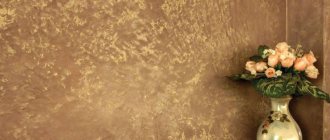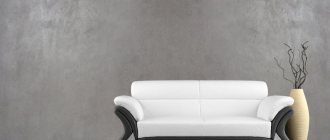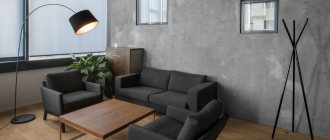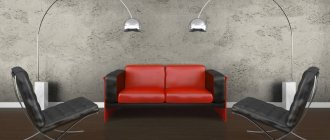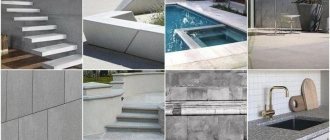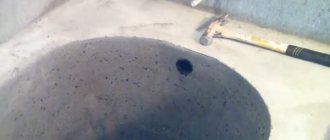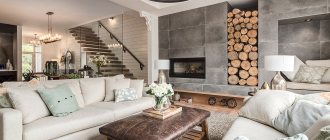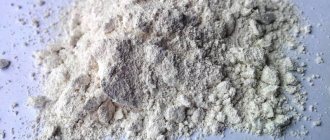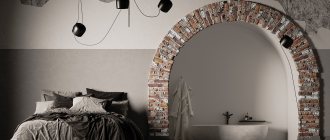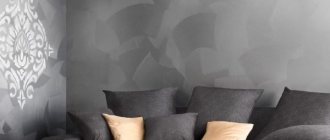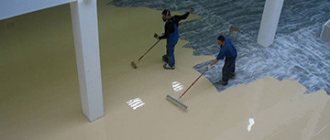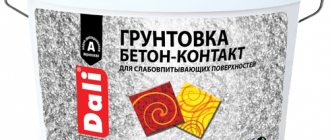If you are tired of the same type of wall decor (wallpaper, paint, whitewash), take a closer look at art concrete. This type of decorative plaster helps transform the interior to a degree of exclusivity. We know how to find the right approach to this matter and what points to pay close attention to.
Decorative plaster - art concrete, allows you to create an imitation of new concrete, stone, mortar smudges, etc.
The building material is made on a one-component basis, usually cement of the required grade. In production, to improve the properties of decorative plaster (quick setting, ductility, strength), the necessary additives are added to the dry mixture.
RECOMMENDED ON THE TOPIC
- Laying paving slabs on concrete
- Decorative plaster…
Working with art concrete requires virtually no skill. With a professional approach, the coating looks very stylish, but amateur work can also justify itself. The wizard can easily create one of the following textures:
- holes;
- mud hut;
- strokes;
- fan effect.
A plasterer who creates uniqueness and beauty of texture is like an artist who recreates a unique, surreal picture. First, decorative plaster is applied in 1-2 layers. The thickness depends on the relief of your future idea. For example, to create some kind of recesses and slits, you need a good layer of art concrete.
Further, it takes at least 3 days for the surface to completely set. You can apply a protective impregnation to the canvas to make the top layer shiny or matte using varnish. The finished surface is moisture resistant and can even be washed if necessary.
Decorative plaster, visually, one might say, is no different from the concrete we are used to. The canvas not only completely replicates the color and texture of this material, but also adds artistic effects. Art concrete fits perfectly into interiors decorated in grunge, high-tech, military, loft, and art deco styles. But it can be successfully used in other styles and directions.
What is art concrete
Architectural or art concrete is understood as a modern material for decorative design and pouring work, which is made on the basis of cement and gypsum powder. The composition includes various additives and additives that improve the technical, operational and aesthetic parameters of art concrete. Using a plastic mixture, you can even create various decorations and imitate natural stone coating. Other names for art concrete are arch concrete, artistic concrete, sculptural concrete.
The difference between art concrete and conventional material
Architectural concrete began to be sold on the market as a building material in the 60s of the last century. Its important difference from the standard solution is that it is used not only in gray, but also in colored form, and in the widest range of colors.
Other distinctive characteristics of art concrete are:
- fine-grained texture of the mixture, thanks to which the finished coating is sanded to perfect evenness and smoothness;
- low absorbency, which makes it possible to use outdoors and maintain integrity even under the influence of precipitation;
- no cracking due to regular temperature changes;
- extensive application possibilities and high aesthetics;
- the ability to add unusual ingredients to the composition (for example, shells).
Principles of application
The originally implemented sloppy relief adds a special “zest” to the decoration of the room. The use of this building material makes it possible to recreate unique textures using various construction techniques. They are made in a wide shade palette of gray and other colors, which in turn increases the scope of application.
Microconcrete can be polished to perfect smoothness. The plasticity of the finished solution is quite high; it becomes possible to slowly create the relief, in agreement with the developed finishing solution. The long-lasting flexibility of the mass allows you to apply wall figures using polymer stencils.
Types of art concrete
Art concrete can be roughly grouped by purpose:
- For finishing work inside and outside buildings (decorative plaster or white decorative art concrete). It has a pleasant, soft structure, allowing you to create both smooth coatings and textured imitations, panels, slabs.
- For casting large-scale works and interior applications (white lightweight art concrete). Durable, aesthetic, ideal for the production of designer objects and sculptures.
There is another classification of types of art concrete depending on its purpose:
- Geometric. It is used for the construction of monolithic structures by pouring mortar into the formwork. It is closest in composition and method of use to standard concrete.
- Decorative. With its help, finished surfaces and buildings are decorated. Well suited for exterior and interior finishing work.
- Sculptural. Suitable for casting artistic and architectural forms, decorations. Also used for sculpting and molding small products.
About the types of architectural concrete
Since explanations regarding the terminology regarding art concrete are very contradictory on the Internet, many people cannot really understand what it is. So first let's give a brief explanation.
There are three main areas of application for architectural concrete. This:
- Production of monolithic facade structures, including those with a three-dimensional front surface.
A building with an unusual facade made of architectural concrete
- Application for casting artistic objects (sculptures, bas-reliefs, elements of facade decor and stairs), small architectural forms, monolithic surfaces with relief.
Outdoor flowerpot
Art concrete: wood for the garden terrace
The area in front of the house made of printed concrete
- Finishing the external and internal surfaces of existing building structures in order to give them a finished appearance. When using it, as in the first two cases, the shape obtained with the help of formwork is not used, but only the texture is important. That is, the third type of art concrete is simply decorative plaster.
Art concrete in the interior
The predominance of certain properties of polymer concrete depends on the specific set of ingredients in its composition. As you may have guessed, it was the third version of concrete that received the prefix “art” (art). Here, too, there are several technologies that were patented in the USA half a century ago, but they began to be used here not so long ago.
One of them is the so-called printed (stamped) concrete, which, being applied to the base, is processed in a still plastic form with a tool for applying relief. There is also sprayed decorative concrete, and there is colored concrete, with which you can very reliably imitate stone or brick masonry.
It's hard to guess that this design is made of printed concrete
It is enough to have a plastic or rubber matrix (stamp) on hand, with the help of which the desired relief is applied to the surface of the uncured plaster. This can also be an imitation of wood pattern. For maximum realism, the formatted surface is perfected using decorative paints.
Stamp for forming the relief of masonry
Composition of art concrete
Since the tasks assigned to concrete are different, their composition will not be the same. It is mainly varied with the help of additives that regulate physical properties (plasticity, hardening rate, hydrophobicity) and decorativeness. The polymer component, as well as some types of plasticizers and mineral additives, give the mixture excellent plasticity.
To create such beauty, the plasticity of the material is very important.
There is no coarse aggregate in decorative concrete; ground rocks (for example, volcanic tuff), limestone and, of course, quartz sand are used to strengthen the compositions. Setting and hardening times are regulated by special hardeners; if necessary, air-entraining, compacting or water-repellent additives are introduced into the composition.
But to achieve the desired texture, the following ingredients can be added to the art concrete:
- colored glass;
- mica;
- ceramic chips;
- dolomite, basalt, granite, marble crushed into flour.
Decorative tiles made of colored concrete
Note: To obtain colored concrete, a mineral pigment is introduced into it - mainly salts or metal oxides. But more intense colors are provided by dyes of organic origin. They are introduced into the composition together with leveling additives, which contribute to a more uniform distribution of color throughout the concrete mass.
This amount of additives is typical only for concrete used to create decorative coatings. They reduce the strength of the stone, so mixtures intended for structural use are made traditionally, with longer hardening times.
If the supporting structure must be colored, it is painted superficially, or the concrete is made white by adding the bleaching agent titanium dioxide, which also has a beneficial effect on cement, increasing its strength. That is why the elements of facade architecture are overwhelmingly white.
The splendor of façade architecture in Art Nouveau style
Characteristics and composition of the material
Any art concrete has high strength. On average, it is 39 MPa 3 days after setting and 59 MPa after 28 days. The whiteness of the finished composition varies between 68-85%, the minimum frost resistance is 100 cycles of freezing and thawing. Art concrete sets quickly and gains strength after 15 hours.
The basic composition of the material is not fundamentally different from classical solutions. Art concrete includes a binder component - Portland cement of white, light gray color M400 or M500 strictly without foreign inclusions and lumps. M600 and M700 cements are used much less frequently for the production of mixtures. The composition also includes quartz sand, which can be partially (up to 5-10%) replaced with granite, marble chips or glass powder.
In addition, art concrete may include other ingredients:
- fine-grained crushed stone, pebbles, shells of a certain shade (to add decorativeness);
- plasticizers, curing regulators, additives to enhance frost resistance, water repellents;
- fiberglass or other reinforcing fibers.
Pigments can be added to the mixture so that it immediately acquires the desired color. Also, purified water in a certain amount is used to prepare the material. In addition to the main binder (cement), art concrete may also include other components with similar properties:
- Acrylic (acrylic resin). The finished material dries quickly, has high elasticity, is easier to tint, and is suitable for rooms with unstable humidity and temperature. The service life of art concrete increases to 10-15 years.
- Minerals - clay, lime, gypsum. They make the composition more decorative, increase abrasion resistance, and provide fire safety.
- Silicates. Provide the highest resistance to damage and chemicals, and repel water. They are used if art concrete is intended for outdoor use.
- Silicone. Gives plasticity, strength, resistance to moisture and ultraviolet radiation.
Application of art concrete
The material is well suited for interior decoration and cladding of exterior objects. It can be applied to walls and various structures or poured into formwork, matrices, obtaining figures of any type.
Interior
Artistic concrete allows you to create a seamless coating for walls, partitions, columns, ceilings and various architectural elements. Provided that moisture-resistant additives are added or an additional protective coating is applied, it can be used even in the bathroom and other wet areas. Using art concrete, they make cladding with a travertine effect and fill molds for stucco molding, furniture, arches, niches, etc.
Interesting solutions for using the material are:
- panels with three-dimensional decor;
- columns, cornices;
- decorative grilles;
- imitation stone;
- decorations for stairs, etc.
Facade
With the help of beautiful and unusual bas-reliefs made of art concrete, you can provide building facades with an original appearance. Also, the outer walls are covered with concrete to imitate a stone coating. Columns and arches, as well as various figures for decorating buildings, are cast from this material.
Local area
To decorate the territory of your site, you can make yourself or order any figures and sculptures from a specialized workshop. Most often, the following art concrete products are used in home areas:
- flower beds, flowerpots for flowers, shrubs;
- fountains, decorative bridges over mini-reservoirs;
- figurines of animals, fairy-tale characters;
- lamps and fixtures;
- tiles, borders, fences and posts;
- tables, benches, sofas and other outdoor furniture;
- decorative geometric shapes.
Surface preparation
Before finishing work, preliminary preparation of the base is required. According to the standards, the surface must be smooth, with a homogeneous mass, dry and cleaned. It is necessary to remove loosely fixed elements and layers of old paint and varnish coatings.
Chips and cracks are smoothed out with putty or special finishing plaster. The surfaces need to be sanded with sheets of fine-grained sandpaper.
Dust is removed with a soft brush or vacuum cleaner. In the work you can use spatulas, a stainless steel trowel, grouting compound, etc.
Pros and cons of art concrete
The material has many positive characteristics. Its advantages include the following:
- strength, good load tolerance;
- abrasion resistance, suitable for pouring floors;
- resistance to temperature changes, water, chemicals;
- long service life;
- environmental friendliness, breathability and fire safety;
- versatility, ability to be used for interior and exterior decoration, pouring, sculpting;
- high decorativeness, use of different shades, textures, suitability for many interior styles;
- rapid hardening, early start of operation;
- easy to care for, no damage from washing with SMS;
- UV tolerance;
- leveling differences and defects in foundations;
- additional noise and heat insulation of premises;
- affordability.
The disadvantages include the presence of chemical components in some types of art concrete, due to which its environmental friendliness is reduced. When planning complex finishing, there is a risk of not being able to complete the job if you do not have sufficient experience. In some cases, you will have to abandon decorating walls with art concrete, because it creates quite a large additional load.
Advantages and disadvantages of the material
Plaster for concrete in the interior has a number of its own characteristics - both advantages and disadvantages.
The most significant “advantages” of this material are the following:
- Ease of operation. To apply such plaster, you will not need to involve specialists with specialized skills - you can easily do without outside help. Having familiarized yourself with the basic recommendations for work, it is not difficult to create a suitable surface relief.
- The work can be done quickly - the raw material is flexible and dries in the shortest possible time. Do-it-yourself decorative plaster for concrete can be installed faster than many other materials, even if the room has high humidity.
- Heat resistance. The coating can be used in rooms where temperature changes are not uncommon.
- Moisture resistance (does not apply to all materials). If there is consistently high humidity in the room, then a coating of this type would not be a bad solution. Why is that? Its hygroscopicity plays a decisive role - the porous structure makes it possible to absorb excess moisture.
The statement about moisture resistance is true only for individual types of mixture; in all other cases, a protective coating must be applied.
- Versatility - the material is suitable for different styles. A beautiful texture will add exclusivity to any room - it can be not only a home, but also an office.
- The textured coating not only has an inimitable appearance, but also has significant technical characteristics - it effectively absorbs sound, which is why it often decorates audio studios.
- Non-flammable, resistant to fungi.
- It does not require special care. The finishing appeals to practical people who do not tolerate great frills.
But there are also disadvantages of such compositions as loft concrete - you need to remember them:
- High price. Loft decorative plaster (even domestically produced) looks expensive but is also worth it.
- If decorative plaster for concrete is installed with your own hands, then when working with the material you need to remember the importance of following the application technology.
Art concrete application technology
Before starting work, a ready-made or self-made building mixture is diluted, the necessary pigments and decorative elements are added to it. Then they begin to apply plaster or pour art concrete into the mold.
Surface preparation
The base must be fairly level, dry, and free of dirt. All poorly adhering elements, old paintwork, and falling off plaster must be removed from it. Chips, holes, and cracks are repaired with regular cement mixture. Grease stains are wiped off with a degreaser. The surface is sanded with fine-grain sandpaper, dust is removed with a vacuum cleaner, and then primed with 2 layers.
Procedure for working with art concrete
The first layer of material is applied to the base and leveled with a spatula or trowel. After it dries, a second layer is performed, on which the selected pattern is formed with light movements of any convenient tool. As it partially dries, the edges of the design are smoothed out a little with a trowel.
If necessary, add individual strokes to imitate voids and cavities, cracks in concrete. The coating must dry for at least 15-24 hours at a temperature of about +22 degrees and humidity up to 65-70%. If the art concrete has not been tinted in advance, painting is done by spraying, stamping or painting over stencils.
Shaping products
Art concrete can be poured into any shape. To ensure that there are no voids inside, the material is compacted. Further work with the product is carried out only after it has thoroughly dried (usually after 2 days). To make the surface of the object smooth, it is ground, polished, and uneven surfaces are removed by sandblasting. In addition, the product is molded using the following methods:
- embossing with a relief roller or stamp (panels, bas-reliefs);
- vibration pressing (paving slabs);
- simple pressing (stucco molding, decorative elements).
Examples of colors and textures
When choosing a specific shade for art concrete, you need to be guided by the interior style and design concept. Below are popular colors for different style trends:
- Provence - pink, beige, milky, blue;
- eco - olive, green, brown;
- minimalism - gray, black, white;
- classic - gray, brown, white;
- high-tech - black, white, metallic;
- futurism - light green, red, fuchsia;
- country - sand, brown, yellow.
Examples of colors and textures
When choosing the color of the plaster, the style direction of the room’s design is taken into account:
- Provencal - soft pink, blue, creamy milky;
- eco - dark brown, olive, marsh;
- minimalism - black, gray, snow-white;
- high-tech - metallic gray, black, snow-white;
- baroque - pastel shades;
- pin-up - soft pink, warm yellow;
- classic - white, gray, chocolate;
- modern - beige, brown, dark blue, emerald;
- futurism - white, lemon, light green, turquoise, ultramarine;
- country - sand, soft yellow, terracotta, dark brown;
- loft - blue, orange, red, dark green.
Based on texture, materials are divided into the following types:
- Structural.
The composition includes granules and fibers of different sizes that form a textured layer.
- Terrasite.
The composition allows you to simulate mining rocks.
- Venetian. The composition includes marble chips, lime and polymer particles, plasticizers, and tint fillers. Venetian plaster is characterized by its structural uniformity and ensures the creation of a smooth surface. The coating allows you to create an imitation of onyx and marble.
- Marseille wax.
The composition has a soft texture and becomes smooth after drying. It allows you to reproduce the imitation of stone, wood and sandstone. The filler is cellulose fibers. The material is used to create interiors in Provencal and country styles.
- Bark beetle
The pattern is optimal for all types of decorative plaster with the addition of different sizes of granules. Fine-grained compounds are used for interior finishing. Depending on the application method, the furrows are placed horizontally and vertically.
- Sgraffito.
Includes multiple layers of different colors with a design engraved on the outer layer. The ornament is engraved 5-6 hours after the mass is distributed.
- Craquelure.
The product presents the effect of an aged surface. The composition is used for different types of bases. First, painting is done with acrylic dye. To achieve the aging effect, the paint is distributed in chaotic strokes. A translucent varnish is applied on top and left for 3-4 hours until dry.
- Latex plastic.
The product allows you to reproduce a glossy surface simulating marble or other stone. The composition is characterized by moisture-resistant characteristics and increased elasticity.
- Wet silk.
The composition is distinguished by mother-of-pearl particles, which make it possible to reproduce the shimmer of silk fabric. The material is optimal for finishing the kitchen, living room, hallway, and bedroom.
- Sea breeze.
The texture is characterized by roughness, the presence of fine-grained sand and pearlescent chips in the structure. The surface reproduces the texture with patterns of waves, sand dunes, and shading.
Decorative plaster for concrete - do it yourself
You can create art concrete for various works with your own hands. To do this, you need to take 1 part white Portland cement, 3 parts fine quartz sand and about 2 parts water. To obtain the desired shade, 2-5% of dry pigment is introduced. Plasticizers and modifiers are also added (usually at home this is PVA, which is poured in when diluting the solution).
The dry ingredients are sifted through a fine-mesh sieve, then combined and mixed until smooth. Make a depression in the center of the mass, add water and stir until a homogeneous solution is obtained.
Popular manufacturers
In construction stores you can most often find the following brands of material:
- "Arbet". Art concrete of high quality at a competitive price, produced in Russia.
- "Dekostroy". The company creates architectural concrete for landscape design.
- San Marco. Materials under the Concret Art brand allow you to create coatings with the effect of aging, cellular concrete and patination.
- "Decorazza." Italian manufacturer of art concrete. Offers material with already added pigments in 15 color variations.
- Introduces “Art Concrete” decorative plaster on the market based on acrylic copolymers and stone chips.
- "Asti." The Russian company produces decorative materials with fine and coarse fillers and with mica additives.
Architectural concrete is an incredibly interesting and multifaceted material that can be used independently in the interior and exterior of a home. It gives you a chance to completely transform your home and area without spending extra money.
